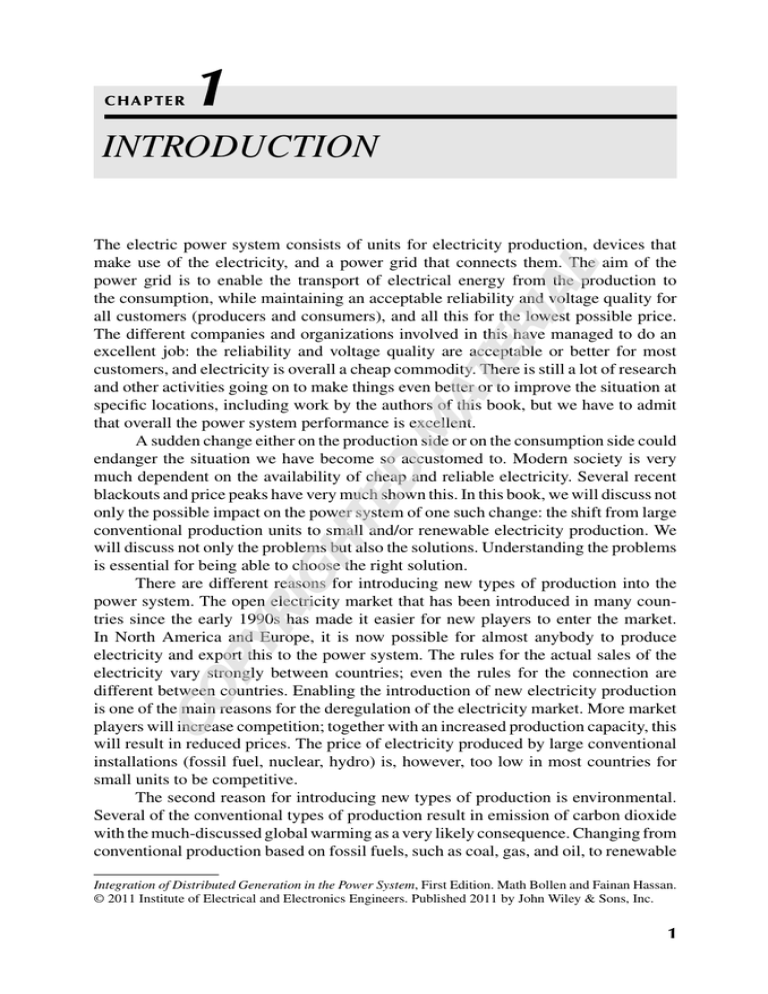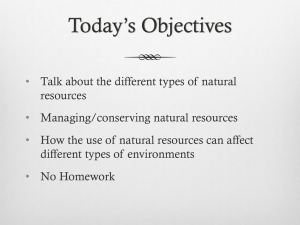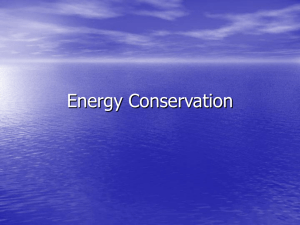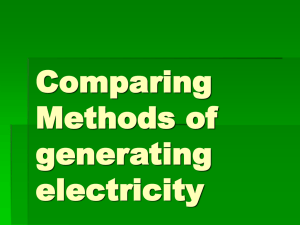1 INTRODUCTION
advertisement

CHAPTER 1 INTRODUCTION CO PY RI GH TE D MA TE RI AL The electric power system consists of units for electricity production, devices that make use of the electricity, and a power grid that connects them. The aim of the power grid is to enable the transport of electrical energy from the production to the consumption, while maintaining an acceptable reliability and voltage quality for all customers (producers and consumers), and all this for the lowest possible price. The different companies and organizations involved in this have managed to do an excellent job: the reliability and voltage quality are acceptable or better for most customers, and electricity is overall a cheap commodity. There is still a lot of research and other activities going on to make things even better or to improve the situation at specific locations, including work by the authors of this book, but we have to admit that overall the power system performance is excellent. A sudden change either on the production side or on the consumption side could endanger the situation we have become so accustomed to. Modern society is very much dependent on the availability of cheap and reliable electricity. Several recent blackouts and price peaks have very much shown this. In this book, we will discuss not only the possible impact on the power system of one such change: the shift from large conventional production units to small and/or renewable electricity production. We will discuss not only the problems but also the solutions. Understanding the problems is essential for being able to choose the right solution. There are different reasons for introducing new types of production into the power system. The open electricity market that has been introduced in many countries since the early 1990s has made it easier for new players to enter the market. In North America and Europe, it is now possible for almost anybody to produce electricity and export this to the power system. The rules for the actual sales of the electricity vary strongly between countries; even the rules for the connection are different between countries. Enabling the introduction of new electricity production is one of the main reasons for the deregulation of the electricity market. More market players will increase competition; together with an increased production capacity, this will result in reduced prices. The price of electricity produced by large conventional installations (fossil fuel, nuclear, hydro) is, however, too low in most countries for small units to be competitive. The second reason for introducing new types of production is environmental. Several of the conventional types of production result in emission of carbon dioxide with the much-discussed global warming as a very likely consequence. Changing from conventional production based on fossil fuels, such as coal, gas, and oil, to renewable Integration of Distributed Generation in the Power System, First Edition. Math Bollen and Fainan Hassan. © 2011 Institute of Electrical and Electronics Engineers. Published 2011 by John Wiley & Sons, Inc. 1 2 CHAPTER 1 INTRODUCTION sources, such as sun and wind, will reduce the emission. Nuclear power stations and large hydropower installations do not increase the carbon dioxide emission as much as fossil fuel does, but they do impact the environment in different ways. There is still carbon dioxide emission due to the building and operation even with these sources, but this is much smaller than that with fossil fuel-based production. The radioactive waste from nuclear power stations is a widely discussed subject as well as the potential impact of an unlikely but nonetheless serious accident. Large hydropower production requires large reservoirs, which impact the environment in other ways. To encourage the use of renewable energy sources as an alternative, several countries have created incentive mechanism to make renewable energy more attractive. The main barrier to the wide-scale use of renewable energy is that it is cheaper to use fossil fuel. Economic incentives are needed to make renewable energy more attractive; alternatively, fossil fuel can be made more expensive by means of taxation or, for example, a trading mechanism for emission rights. Some of the incentive schemes have been very successful (Germany, Denmark, and Spain), others were less successful. The third reason for introducing new production, of any type, is that the margin between the highest consumption and the likely available production is too small. This is obviously an important driving factor in fast-growing economies such as Brazil, South Africa, and India. In North America and Europe too, the margin is getting rather small for some regions or countries. Building large conventional power stations is not always politically acceptable for, among others, environmental reasons. It also requires large investments and can take 10 years or longer to complete. Small-scale generation based on renewable sources of energy does not suffer from these limitations. The total costs may be higher, but as the investments can be spread over many owners, the financing may actually be easier. The right incentive schemes, economically as well as technically, are also needed here. Instead of building more generation, the recent trend, for example, in Northern Europe, is to build more transmission lines. In this way, the production capacity is shared among transmission system operators. Building transmission lines is often cheaper than building new power stations, so this can be a very attractive solution. Another reason for building new lines instead of new production is that in most countries there is no longer a single entity responsible for ensuring that there is sufficient production capacity available. This means that no single entity can order the building of new production. It is, however, the task of the transmission system operator to ensure that there is sufficient transmission capacity available for the open electricity market. The transmission system operator can decide to build new lines to alleviate bottlenecks that limit the functioning of the open market. Although growth in electricity consumption has been moderate for many years in many countries, there are reasons to expect a change. More efficient use of energy often requires electricity as an intermediate step. Electric cars are the most discussed example; electrified railways and heat pumps are other examples. Even the introduction of incandescent lamps 100 years ago was an improvement in energy efficiency compared to the candles they were replacing. No matter what the arguments are behind introducing new electricity production, it will have to be integrated into the electric power system. The integration of large production units, or of many small units, will require investments at different INTRODUCTION 3 voltage levels. The connection of large production units to the transmission or subtransmission system is in itself nothing remarkable and the investments needed are a normal part of transmission system planning. With new types of production, new types of phenomena occur, which require new types of solutions. Small production units are connected to the low- or medium-voltage distribution system, where traditionally only consumption has been connected. The introduction of large numbers of them will require investments not only at the voltage level where the units are connected but also at higher voltage levels. The variation in production from renewable sources introduces new power quality phenomena, typically at lower voltage levels. The shift from large production units connected at higher voltage levels to small units connected at lower voltage levels will also impact the design and operation of subtransmission and transmission networks. The difficulty in predicting the production impacts the operation of the transmission system. The terminology used to refer to the new types of production differs: “embedded generation,” “distributed generation,” “small-scale generation,” “renewable energy sources” and “distributed energy resources” are some of the terms that are in use. The different terms often refer to different aspects or properties of the new types of generation. There is strong overlap between the terms, but there are some serious differences as well. In this book, we will use the term “distributed generation” to refer to production units connected to the distribution network as well as large production units based on renewable energy sources. The main emphasis in this book will be on production units connected to the distribution network. Large installations connected to the transmission system will be included mainly when discussing transmission system operation in Chapter 8. In this book, we will describe some of the ways in which the introduction of distributed generation will impact the power system. This book has been very much written from the viewpoint of the power system, but the network owners are not the only stakeholders being considered. The basic principle used throughout the book is that the introduction of new sources of production should not result in unacceptable performance of the power system. This principle should, however, not be used as a barrier to the introduction of distributed generation. Improvements should be made in the network, on the production side and even on the consumption side, to enable the introduction of distributed generation. Several possible improvements will be discussed throughout this book. We will not discuss the difficult issue of who should pay for these investments, but will merely give alternatives from which the most cost-effective one should be chosen. The structure of this book is shown in Figure 1.1. The next two chapters introduce the new sources of production (Chapter 2) and the power system (Chapter 3). Chapters 4–8 discuss the impact of distributed generation on one specific aspect of the power system: from losses through transmission system operation. As already mentioned, Chapter 2 introduces the different sources of energy behind new types of electricity production. The emphasis is on wind power and solar power, the renewable sources that get most attention these days. These are the two sources that will constitute the main part of the new renewable sources of energy in the near future. However, more “classical” sources such as hydropower will also be discussed. The different sources will be described in terms of their variation 4 CHAPTER 1 INTRODUCTION Chapter 2 Chapter 3 Section 4.1 4.2 4.3 4.4 Section 4.5 … … … … Section 8.1 … … … … Section 8.13 Figure 1.1 Structure of the book: introductory chapters and chapters on specific phenomena. in production capacity at different timescales, the size of individual units, and the flexibility in choosing locations. These are the properties that play an important role in their integration into the power system. After a general overview of the power system, Chapter 3 introduces, the “hosting capacity approach.” The hosting capacity is the maximum amount of generation that can be integrated into the power system, while still maintaining its performance within acceptable limits. The hosting capacity approach uses the existing power system as a starting point and considers the way in which distributed generation changes the performance of the system when no additional measures are taken. For this, a set of performance indicators is needed. This is a normal procedure in the power quality area, but not yet in other areas of power systems. Chapters 4–8 discuss in detail various aspects of the integration of distributed generation: the increased risk of overload and increased losses (Chapter 4), increased risk of overvoltages (Chapter 5), increased levels of power quality disturbances (Chapter 6), incorrect operation of the protection (Chapter 7), and the impact on power system stability and operation (Chapter 8). Chapters 3–8 are structured in the same way, as shown in Figure 1.1. Considering Chapter 5, for example, the first section gives an overview of the impact of increasing amounts of distributed generation on the voltage magnitude as experienced by the end customers. The first section in each chapter is both a summary of the results from the forthcoming sections and an overview of material obtained from the literature. The sections following the first section discuss different details of, in this case, the relation between distributed generation and voltage magnitude. Some of the sections look at the problem from a different perspective or discuss a specific solution. Some of these sections give a general overview, while others go deeper into theoretical models or research results. Most of these sections can be read or studied independent of other sections. The final section of the chapter gives an overview of methods for allowing more distributed generation to be connected without experiencing problems with, in this case, voltage magnitude. The final section of each chapter is again a combination of material from the rest of the chapter and material obtained from the literature. The different solutions presented here include those that are currently referred to as “smart grids.” This term has received a huge amount of interest, all the way from fundamental research to politics and newspapers, but it remains unclear what should be included in the term. We will not distinguish here between “smart grid solutions” and “classical solutions,” but instead present all the available options. INTRODUCTION 5 It is not possible to cover all aspects of the integration of distributed generation in one book. The economic aspects of the different impacts of distributed generation and of the different methods for increasing the hosting capacity are not treated here at all. This is not because economics are not important, they are in fact often the main deciding factor, it is just that we had to stop somewhere. Besides, the economics are very much location and time dependent. The book does not include many detailed simulation studies, but mainly simplified models of the power system and of the distributed generation. There are a number of reasons for this. We would like to propagate the use of such simplified models as a tool to be used during initial discussions; it is our experience that important conclusions can often be drawn from these simplified models. We are also of the opinion that the use of simplified models has a great educational value. The impact of different parameters is much better understood when simplified models rather than detailed simulations are used. Such detailed calculations are, however, needed in many cases before connecting distributed generation to the power system. The structure of the power system is different across the world and the details are very much location dependent. The simplified models of the type presented in this book can be easily adapted to a local situation, whereas simulation studies have to be repeated for each location.








